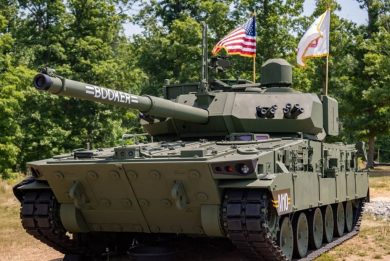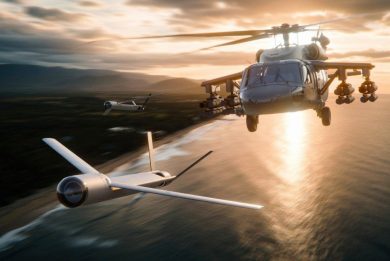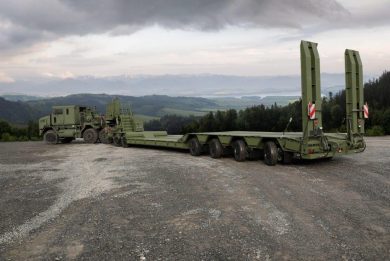
AUSA Noon Report: the US Army in Europe and Africa, the CG view
By Paolo Valpolini
With the end of the Cold War the United States considerably reduced their military presence in Europe. Other areas of the world acquired higher priorities, such as the Middle East and India-Pacific, and more recently Africa. The foreign policy guidelines of the US administrations of the last decades had different priorities, however the US military remained in Europe, its land component falling under the US Army Europe command. In 2008 US Army Africa was formed, its HQ being based in Italy coinciding with the so-called Southern European Task Force, SETAF in short. On October 1st 2020 these two organisations came together forming what is now US Army Europe and Africa (USAREUR-AF), headquartered in Wiesbaden, Germany. Its current Commanding General is Gen. Christopher G. Cavoli, who from January 2018 until the consolidation led US Army Europe. Gen. Cavoli was recently the host of the Association of the United States Army (AUSA) Noon Report, the meeting of course taking place virtually due to the pandemic. EDR On-Line could not miss the opportunity to hear from the voice of the highest ranking US Army representative in Europe his views on what the US land service is, and will become, on the Old Continent, and his opinion on the consolidation of the two commands. The interview was led by Gen. (ret) Carter F. Ham, AUSA President and CEO.
“The merger of the two commands really presents some big opportunities for us. It gives me the opportunity to align some of my operations activities and investments with the security and trusts of many of our allies, especially our southern-European allies. Previously, as the Commander of US Army Europe, I had natural relationship with all of our European allied armies. But when some of them would want to discuss their operations or their interests in Africa I would have to waive that off because that was not my area of responsibility. Now it is. Now I can have that conversation. One of the first things that we did after assuming control of Army Africa was to have an extended series of VTCs with the Army chiefs of Portugal, Spain, France, Italy and other allies who are interested in Africa, because many of their security challenges are closely related to the African continent. What the consolidation does, it gives us the opportunity to think hemispherically, to think across the entire hemisphere about security,” Gen. Cavoli explained. He also added that the new command structure allows to adjust and employ US Army Europe assets, previously aimed only at the Old Continent, against African problems set as well, increasing flexibility in terms of resourcing, operations activities and investments in Africa, as opposed to having no assigned forces there. The merger was not limited to assume new responsibilities. “We also got a headquarters to help us, that of the Southern European Task Force and Africa located in Vicenza, Italy.”

Ready to move to Tunisia for talks with the Chief of that Army Gen. Cavoli stated that one of the subjects of discussion topics, among others, will be the activity of the Security Force Assistance Brigade, which deployed its assets there, helping with some capacity developments at institutional level, the SFAB being definitely a key instrument to improve cooperation with allied nations.
While the Army merged its European and African HQs, this is not true at joint level, hence now US Army Europe and Africa depends from two Joint Combatant Commands, the United States European Command and the United States African Command, both based in Stuttgart, Germany, as these remain separate, which led to adjustments within the headquarters structure to cope with the new responsibilities.
Looking to Africa is functional also to the Atlantic Alliance: Gen. Cavoli underlined that NATO is not a one-problem alliance, it has a 360-degree approach, strategic direction south being an important part of SACEUR’s approach to deterrence and defence of the Alliance. So in that context the merging of the two former US Army regional commands allows Gen. Cavoli to look in all directions, the additional work being thus absolutely worth, according to his words.
Shifting to the role of the US Army in the competition phase, in this moment of Great Powers confrontation its first role is deterring and preventing conflicts. “The first and foremost thing we do is obviously to prepare, so that we are ready to fight and win, which is the sine qua non of deterrence. The first big overarching contribution we make to competition is by being ready. When you go past that, there is a whole kind of things that we do in competition. We are very active in the information space, both responding to misinformation and disinformation as well as promoting our own story and our own truth. Europe has some challenges with disinformation being spread, but we see a lot of it in Africa as well,” the USAREUR-AF Commanding General underlines. “We do have structures that we set up with our allies and our partners where we scan the information space and do the two things we can always do, attribute the story to its true source, and tell the truth. We do it very quickly, usually through our allies video organs, or the context we have operating in the information sphere here in Germany and in Africa as well.” He explains that the competition is for access, information and influence, and this is done through presence and engagement, the first tool being interaction through the relationship that is built with every single allied, building influence and gaining access to their infrastructures needed for military operations. These relationship are not limited to the top brass but are spread through the Command at different levels. “One of the tenets of multi-domain operations in the Army operating concept is calibrating force posture, and part of that calibration is based on how we keep these relationships going so we can sustain the level of influence we have, the access to decision-makers that we have,” Gen.Cavoli says, describing the second USAREUR-AF contribution in the competition phase. “The third one is demonstrate our readiness, and encourage the readiness of our allies and partners, which is one throughout our exercises. Our exercise programme is extensive and is 100% conducted with allies and partners, and it has a demonstration effect in the location where we hold it, as well as an effect by the capabilities we demonstrate.” This is aimed at two different audiences, allies and partners, who are reassured, increasing their confidence on US Army capabilities to get there and reinforce them, and potential adversaries, sending them a message of deterrence. “Finally, in competition, we exercise and maintain access to strategic infrastructures, and that is really important. It is not a secret that China heavily invested in the last years, they are very eager to buy and control ports, airports, rail lines, communication networks,” he explains underlining that all those have an importance both from a military and a commercial standpoint for the countries involved. “We are therefore careful to exercise a diversity, in a multiplicity of ports, lines of communication and lines of operation, and that helps us to continue our understanding of the ownership and the operation of them, but it also points out where are the deficiencies in those infrastructure, and then we can work with NATO and the European Union to fund improvements, especially in areas where NATO has not historically operated during the Cold War.”
Back to the merging of Army Europe and Army Africa headquarters, the new Command CG highlights that as Russia and China are extremely active, competing for influence and access in Africa, it is necessary for the US Army to be able to operate there as well; “We see a lot of ties between activities in the two continents, and that merging gives us the ability to see across the entire hemisphere, not artificially dividing into two different problem sets.”
Exchange of personnel between US and European allies armies is increasing, “As we put the V Corps forward command post in Potsdam, Poland, there are a number of armies who have come forward asking if there will be room in that headquarters for some of their officers, and the answer is yes, because we cannot really envision conducting NATO operations in Europe without our allies, so I do see that expanding. I see some of it rearranging to reflect our current priorities, and our anticipated future priorities as well.” Will this extend also to Africa? “With regards to Africa, it is a different situation, the continent isn’t dominated by a single alliance, as it is in Europe, and we don’t have in some cases as deep, long, historical relations. Some of our allies do maintain an officer in headquarters down there, but I think as we go forward it’s going to be the intention of the US to reinforce positive trends on the continent by careful placement of our people and our activities, so it is possible we will see some exchanges in the future,” Gen. Cavoli states.
The US developed the Multi-Domain Task Force (MDTF) to deal with the new concept of operations, the first one having been deployed and tested into the Asia Pacific region. Will this be extended to Europe, does USAREUR-AF feels the need for it? “We absolutely need it. The capabilities that the MDTF are going to bring, and help us integrate the expertise that they will bring, will be very important to updating the way we plan to operate on the European continent, and we will be able to extend that to the African continent as well. As part of Defender 20, the big exercise that we got most of the way into before having to curtail some of it due to COVID, we did the Army Joint Warfighting Assessment and we brought in Multinational Corps North-East out of Szczecin, Poland, as well as the Allied Rapid Reaction Corps from Innsworth, United Kingdom, bringing them together with our headquarters, and attempted to plan against a hypothetical scenario of large scale combat operations that we projected forward into 2035, so after we will have multi-domain capabilities. We experimented how we would operate with those capabilities and inside a joint and combined force that will be using those capabilities. It was a very illuminating exercise, very challenging, both intellectually as well as on sheer workload and manpower to try to achieve convergence across multiple domains in a combined context at tempo. We would be very eager to get a MDTF. The pilot MDTF has now been regularised and the Army is planning on continuing to build MDTFs.” According to available information Europe should get its MDTF within this year, COVID permitting; it should be based on the 41st Field Artillery Brigade based in Grafenwöhr, Germany, that will be merged with an with an Intelligence, Information, Cyber Electronic Warfare and Space (I2CEWS) element.
But this might not be the only add-on to USAREUR-AF. “For a large scale theatre like ours, which has as part of its responsibilities the ability to wage large scale land campaigns, we are also exited about proposals of something called Theatre Fighters Command, which would develop and curate a whole set of targets during the competitive phase, and then execute during a potential conflict. That The Theatre Fighters Command will also bring enormous capabilities with it, and help us as multi-domain operations promise to push away out of a close fight necessarily, and be able to fight a little bit more at stand-off, so that when we do engage in a close fight it will be under much more advantageous circumstances.
Highlighting the importance of the Defender exercise series, which in 2020 saw the most massive income of reinforcements from the United States into Europe since the Cold War Era, stressing host nation support issues which are key to such operations, Gen. Cavoli explained that 2021 will see a lesser number of manoeuvre forces deployed, but will rather concentrate on high-end key enablers, and will be played in south-eastern Europe, involving mostly Romania and Bulgaria, two countries which are rapidly modernising their forces.
Talking of military mobility throughout Europe Gen. Cavoli split the issue in two, on one side infrastructures, on the other regulations and policies. “Considering infrastructures, when NATO expanded we went into territories that had previously been on the other side of the fence, and there the infrastructure was designed for Warsaw Pact equipment, and was all pointed westward, while we needed infrastructures designed for western equipment pointing eastward. Modern western main battle tanks, once loaded on heavy road transporters, reach a weight of over 100 tonnes, so the requirement for bridges that have an MLC 100 or greater exists, and typically that’s not the specification to which bridges were designed and built on the farther east you go. The same applies to rail heads; a T-90 weighs around 47 tonnes, a T-72 modernised is up to 43 tonnes, almost 60% of the weight of the tanks we have, so the carrying capacity is also short. To work on that we have a great informal partnership with the European Union; as US Army Europe we will catalogue what we know about transportation infrastructures throughout the continent, when we exercise we will check it out and we will survey it, sharing it with the host nation, and then where we think improvements need to be made we agree with the host nation and we route that back through EUCOM to NATO, and NATO has a working group with the EU that helps them to direct their infrastructures funding to dual-use military-commercial infrastructures, and we have a say in the military part of it,” USAREUR-AF CG explains. “On the policy and procedures side there has been quite some progress as well. The key problem is that Europe is made of sovereign countries, which have their own rules for diplomatic clearances, border crossing, transit permissions, many of those being obviously designed for peacetime. Over the past five years we wrestled with long permission request times, one of the problems being the lack of a standard European form for requesting a cross-border transit. The EU organisation I mentioned above has created and is now automating a standard form, and nations are adopting it across Europe. Other progress have been made on bi-lateral and multi-lateral basis; Poland had a 15-day advance notice requirement for non-crisis movement of military material, and now unilaterally lowered it to five days, Lithuania did the same thing to an even greater magnitude, so numerous agreements were made on procedural and regulatory barriers to fluid movements across Europe,” Gen. Cavoli said. What pushed this was EUCOMs and USAREUR exercise programme since 2015, which exposed some of the deficiencies allowing to fix them since. “We also increased the scale and ambition of exercises, because sometimes it is not just procedures and infrastructures, it’s also a question of scale, that’s why the Defender series has proved so beneficial to all of us,” Gen. Cavoli concludes.
The US engagement in Europe is thus far from being over, USAREUR-AF being on the verge of further increasing its capabilities in both continents; a few days after Gen. Cavoli took part in the AUSA Noon Report the new US Administration announced its decision to freeze the withdrawal of 12,000 troops from the Old Continent. Transatlantic cooperation in the military field is far from over.




